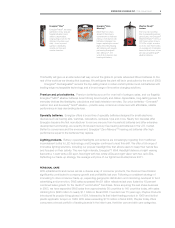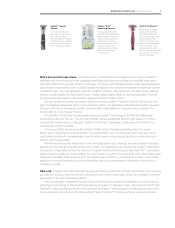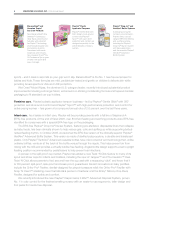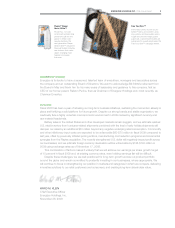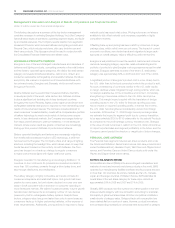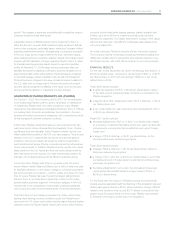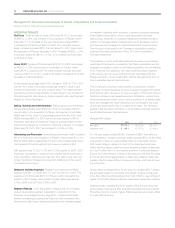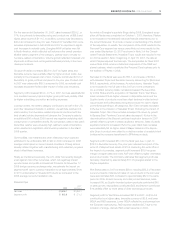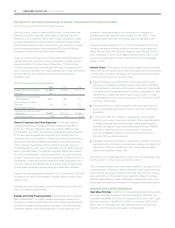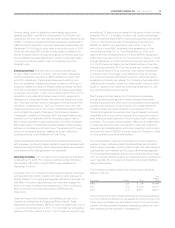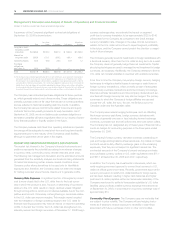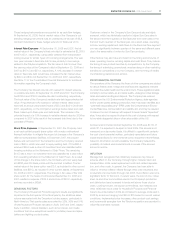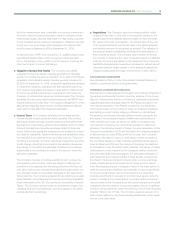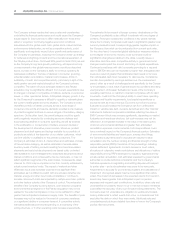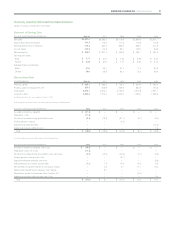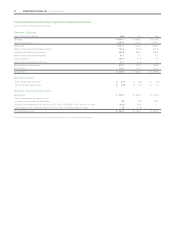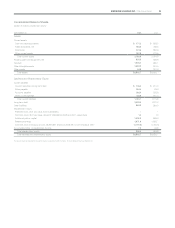Energizer 2008 Annual Report Download - page 17
Download and view the complete annual report
Please find page 17 of the 2008 Energizer annual report below. You can navigate through the pages in the report by either clicking on the pages listed below, or by using the keyword search tool below to find specific information within the annual report.
ENERGIZER HOLDINGS, INC. 2008 Annual Report 15
Working capital, which is defined as current assets less current
liabilities was $665.1 and $888.5 at September 30, 2008 and 2007,
respectively. The year over year working capital change reflects the use
of $261.0 of cash to complete the Playtex acquisition. As adjusted to
reflect the Playtex acquisition, accounts receivable increased $39.4 at
September 30, 2008 due to higher sales in the fourth quarter of 2008.
Inventories decreased $29.5 as the inventory step-up related to the
Playtex acquisition flowed through earnings as the inventory was sold.
Current liabilities decreased $22.8 due primarily to payments related
to exit and contract termination costs for Playtex as part of the
integration plan.
Investing Activities Net cash used by investing activities was
$1,994.5, $82.3 and $115.6 in 2008, 2007 and 2006, respectively.
Capital expenditures were $160.0, $88.6 and $94.9 in 2008, 2007
and 2006, respectively. These expenditures were funded by cash
flow from operations. Capital expenditures increased in 2008 due to
production related spending and Playtex related spending. See Note
18 of the Consolidated Financial Statements for capital expenditures
by segment. On October 1, 2007, the Company paid $1,875.7 for the
acquisition of all outstanding Playtex common stock, repayment or
defeasance of outstanding Playtex debt, and other transaction costs.
See “Financing Activities” below for discussion of the financing of the
transaction. At September 30, 2007, the Company held a net-cash
settled prepaid share option with a major multinational financial institu-
tion to mitigate the impact of changes in the Company’s deferred
compensation liabilities. In December 2007, the prepaid feature was
removed from the transaction and the Company received cash of
$60.5, which was used to repay existing debt. Of the $60.5 received,
$46.0 was a return of investment and was classified within investing
activities on the Statement of Cash Flows. The remaining $14.5 was
a return on investment and was classified as a cash inflow from
operating activities on the Statement of Cash Flows.
Capital expenditures of approximately $150 are anticipated in 2009
with increases in production related capital for existing businesses and
planned spending for Playtex. Such capital expenditures are expected
to be financed with funds generated from operations.
Financing Activities The Company’s total borrowings were $2,959.9
at September 30, 2008. The Company maintained total committed
debt facilities of $3,449.9, of which $479.0 was available as of
September 30, 2008.
In October 2007, the Company borrowed approximately $1,500 under
a bridge loan facility which, together with cash on hand was used to
acquire Playtex. The Company subsequently refinanced the bridge loan
with $890 of long-term debt financing, with maturities ranging from
three to ten years and fixed rates ranging from 5.71% to 6.55% and
$600 of long-term bank financing priced at LIBOR plus 100
basis points.
Under the terms of the Company’s debt facilities, the ratio of the
Company’s indebtedness to its Earnings Before Interest, Taxes,
Depreciation and Amortization (EBITDA) cannot be greater than 4.00 to
1, and may not remain above 3.50 to 1 for more than four consecutive
quarters. If the ratio is above 3.50 to 1, the Company is required to pay
an additional 75 basis points in interest for the period in which the ratio
exceeded 3.50 to 1. In addition, the ratio of its current year Earnings
Before Interest and Taxes (EBIT) to total interest expense must exceed
3.00 to 1. The Company’s ratio of indebtedness to its pro forma
EBITDA, as defined in the agreements, was 3.25 to 1, and the
ratio of its pro forma EBIT, as defined in the agreements, to total
interest expense was 3.91 to 1 as of September 30, 2008. As a
result of the ratio of indebtedness to pro forma EBITDA during fiscal
2008, which was above 3.50 to 1 for the period from January 1, 2008
through September 30, 2008, at which time the ratio reduced to 3.25
to 1, the Company had higher pre-tax interest expense on fixed bor-
rowings of approximately $13.0 for the current year. Failure to comply
with the above ratios or other covenants could result in acceleration
of maturity, which could trigger cross defaults on other borrowings.
The Company believes that covenant violations, which may result in
acceleration of maturity, are unlikely. The Company’s fixed rate debt is
callable by the Company, subject to a “make whole” premium, which
would be required to the extent the underlying benchmark U.S. trea-
sury yield has declined since issuance.
The Company routinely sells a pool of U.S. accounts receivable
through a financing arrangement between Energizer Receivables
Funding Corporation (the SPE), which is a bankruptcy-remote special
purpose entity subsidiary of the Company, and outside parties (the
Conduits). Under the current structure, funds received from the
Conduit are treated as borrowings rather than proceeds of accounts
receivables sold for accounting purposes. Borrowings under this pro-
gram receive favorable treatment in the Company’s debt compliance
covenants. The program renews annually in May. Further deterioration
in credit markets could result in an inability to renew the program or
renewal on less favorable terms, which may negatively impact compli-
ance reported Debt-to-EBITDA and may require the Company to draw
on other available committed debt facilities.
The counterparties to long-term committed borrowings consist of a
number of major multinational and international financial institutions.
The Company continually monitors positions with, and credit ratings of,
counterparties both internally and by using outside ratings agencies.
The Company has staggered long-term borrowing maturities through
2017 to minimize refinancing risk in any single year and to optimize the
use of free cash flow for repayment. See the contractual obligations
table provided below.
The Company purchased shares of its common stock as follows
(shares in millions):
Fiscal Year
Shares
Cost
Total
Average
Price
2008 0.0 $ 0.0 $ 0.00
2007 0.8 $ 53.0 $67.67
2006 11.3 $600.7 $53.02
The Company has 8 million shares remaining on the current authoriza-
tion from its Board of Directors to repurchase its common stock in the
future. Future purchases may be made from time to time on the open
market or through privately negotiated transactions, subject to corpo-
rate objectives and the discretion of management.


